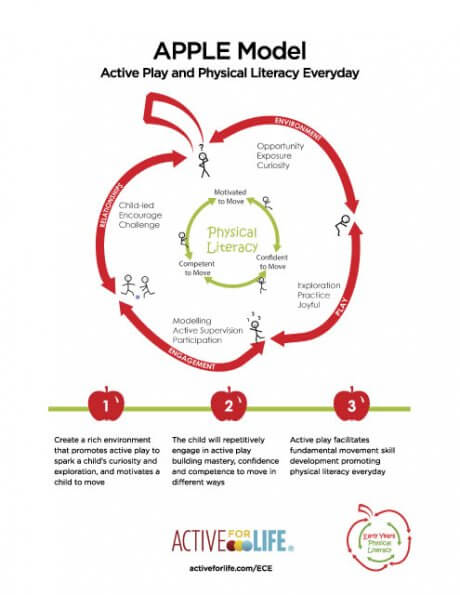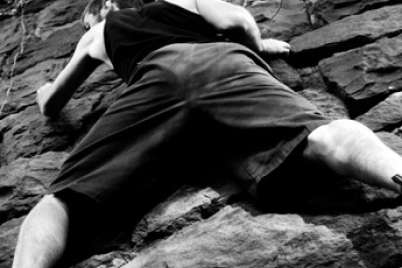
APPLE Model helps early childhood educators incorporate physical literacy
Early childhood educators (or ECEs) are not phys-ed teachers; most don’t have the knowledge or the background to “teach” physical skills. But young children learn through play, especially active play, and that’s something ECEs understand well. Their role is to create many opportunities for children to explore fundamental movement skills in stimulating environments indoors and out.
Physical literacy isn’t just participating in activities that work up a sweat. It’s developing the motivation, confidence, and competence to move for a lifetime.
Physically literate children want to move. They acquire confidence as they challenge themselves, and they build competence as they learn the skills to control their bodies. With many opportunities, the cycle continues and children continue to develop physical literacy throughout their lives, resulting in healthy bodies and minds.
Rather than thinking of physical literacy as something that only happens during “activity time,” ECEs seek out ways to encourage children to move throughout the day, indoors and out. One tool ECEs have to do so is the the APPLE Model (Active Play and Physical Literacy Everyday).
It was developed as a framework to help ECEs understand how to incorporate physical literacy into their playrooms and playgrounds. (You can download poster-sized images or order postcards from our free downloads page on Active for Life.)
Related read: What is physical literacy?
The “core” of the APPLE is the definition of physical literacy: the motivation, confidence, and competence to move for a lifetime. The “skin” of the APPLE reflects four aspects of active play important for all children:
- Environment
- Play
- Engagement
- Relationships
Environment
Educators create stimulating environments that excite children’s curiosity and provide opportunities for them to explore new and thrilling movements and equipment. This exposure enables children to develop new skills. When children find that something doesn’t work, they work out better ways to move and conquer a task, enhancing resilience and problem-solving skills.
Play
Young children learn through play that’s joyful and that they direct. Children love to explore what intrigues them and practice over and over until they achieve a sense of mastery. Watch young children playing with something they have chosen or discovered and watch time disappear. Children need at least 45 minutes to plan and organize their play so extended playtimes are provided each day.
Engagement
Thoughtful educators know how to engage with children to facilitate or extend the play. They know that their active participation when children request it—as well as modeling to show how exciting a new adventure can be—will encourage and support children. When children begin to challenge themselves by trying to climb higher or using tools, the role of the educator becomes that of an engaged supervisor. Educators may guide children to use tools safely or learn how to move their hands and feet to climb. Educators don’t interrupt the play or caution children to “be careful.” Instead, they let children know that they’re close by if needed but also ensure the children can do it–by themselves.
Relationships
Active play builds relationships in many ways—among children, between children and educators, and between educators and parents. Educators understand how to provide opportunities that encourage child-led play and challenge all children to reach above themselves. Children learn to work together, negotiate, settle disputes, and problem-solve when they develop positive relationships with others. When educators, supervisors, and parents work together to understand the value and benefits of active play, children, and the adults in their lives, benefit in multiple ways.
Physical literacy is as important to healthy child development as other literacies such as reading, writing, and numeracy. The benefits of being physically literate are many—cognitively, socially, emotionally, as well as physically.
Related read: Be a lifeguard to your child’s “risky” play
When the APPLE Model is incorporated into programs for young children, physical literacy is visible in all parts of the environment and in all that children do. Children are eager to move in many ways and love to practice until they have mastered a new skill. Then they’re ready to challenge themselves with something new.
Physically literate children are creative, curious, and capable of developing complex play involving others. They plan and make decisions. They also are better prepared for school. They focus and ignore distractions so their play won’t be interrupted. They regulate their emotions so that everyone can participate, which reduces stress and anxiety. As a result, children feel confident and competent in their own abilities and ready to face challenges in the larger world.
When you help the young children in your care develop physical literacy, you give them a gift that will last a lifetime.







Active for Life provides postcards, posters and more to organizations of all sizes wishing to promote physical literacy and healthy child development. Parents love them!
See the items under the Resource tab and contact with [email protected] to request free print materials.
I would love to order the printed inform such as posters and postcards to put around our daycare and for parents to see and read. I have tried to go through the link on your email but I can’t seem to get anywhere. Hopefully this finds the people this needs to go to. Thank you, Jamie Barnett, Playland Daycare, Sooke BC